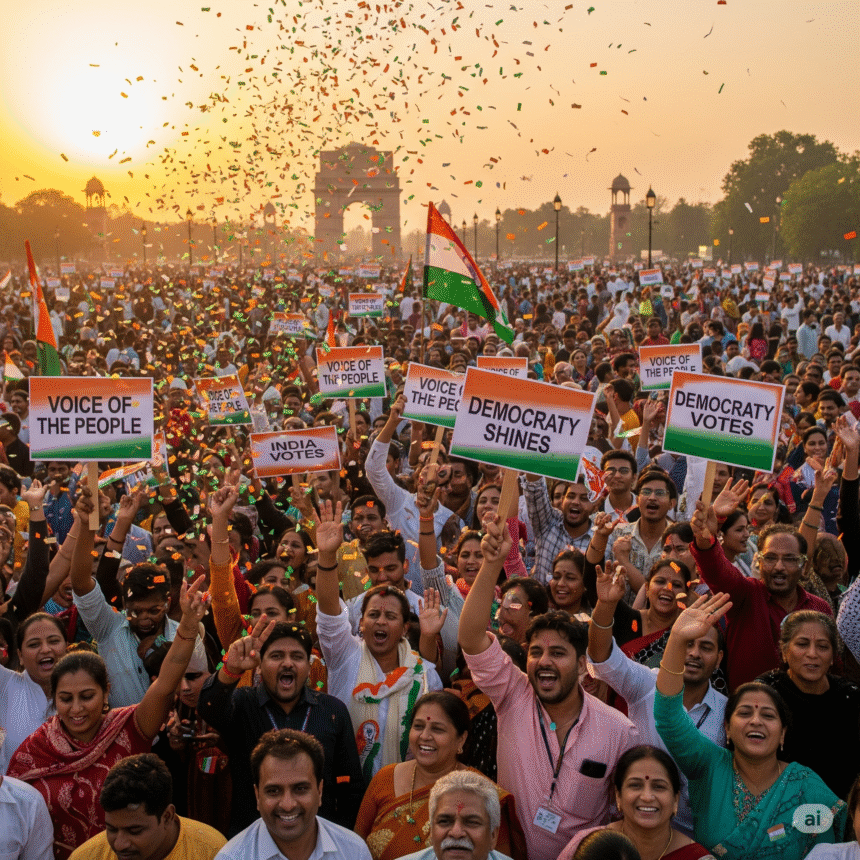Exploring the Strengths and Challenges of Voter Engagement in the World’s Largest Democracy
Key Metrics:
- Voter Turnout: India recorded 67.4% voter turnout in the 2019 general elections, the highest ever in its democratic history.
- Electoral Scale: Over 900 million registered voters participated in elections spanning 1 million polling stations.
- Socio-Economic Disparities: India’s workforce includes 46.5% self-employed individuals, many in low-income jobs, highlighting economic concerns that influence voter sentiment.
- Youth Participation: Nearly two-thirds of India’s population is under 35, with youth playing a critical role in shaping election outcomes.
India’s democracy is a testament to the collective power of its people. From urban hubs to rural heartlands, millions of citizens exercise their right to vote, shaping the future of the nation. This “wisdom of the crowd” reflects India’s deep commitment to democratic ideals. However, beneath the celebration of record voter turnouts and vibrant electoral participation lies a quieter, often overlooked narrative—of disillusionment among sections of the population who feel disconnected from the democratic process.
The Power of Participation: A Story of Engagement
India’s elections are a massive exercise in democratic engagement. The 2019 general elections saw a record voter turnout of 67.4%, with participation cutting across gender, caste, and regional lines. Initiatives like voter awareness campaigns, accessible polling booths, and technological innovations such as EVMs (Electronic Voting Machines)have enhanced the inclusivity of the electoral process.
This collective participation is a reflection of India’s belief in democracy as a tool for change. Citizens have used their votes to demand accountability, advocate for social justice, and support development-oriented policies.
Youth voters, in particular, have emerged as a driving force. With nearly two-thirds of the population under the age of 35, their aspirations and priorities significantly influence election outcomes. Issues like job creation, education, and climate change have found their way into political manifestos, driven by the demands of younger voters.
Disillusionment in the Shadows: A Different Perspective
Amidst this celebration, there exists a segment of the population—often in low-income or unstable jobs—who view voting as a futile exercise. For many daily wage workers, small shopkeepers, and gig economy participants, the outcomes of elections feel detached from their immediate struggles.
The sentiment that “nothing changes, no matter who comes to power” is particularly prevalent among those grappling with economic insecurity. They perceive political promises as distant from their reality, where survival takes precedence over civic engagement. This disillusionment is further compounded by the perception that political leaders prioritize urban elites or corporate interests over the concerns of ordinary citizens.
For these individuals, democracy often feels like a system designed for others, leaving them with little hope that their vote can bring meaningful change to their lives. This disconnect is a stark reminder that democracy must address both symbolic representation and tangible socio-economic outcomes.
Bridging the Gap: A Path Forward
To reignite faith in the democratic process among disillusioned voters, targeted interventions are necessary. Political parties and policymakers must focus on economic inclusion, social security, and livelihood support for marginalized groups.
Greater engagement through grassroots campaigns and local governance initiatives can help connect voters with the democratic process. Providing platforms for direct dialogue between citizens and leaders, especially in economically vulnerable communities, can foster trust and accountability.
Additionally, addressing systemic issues like unemployment, inflation, and inadequate public services can demonstrate that democracy delivers real change for all citizens, not just the privileged few.
The Role of Awareness and Education
Voter education plays a critical role in bridging the gap between the promise of democracy and its perceived impact. Programs that emphasize the importance of voting, even in challenging circumstances, can inspire participation. Highlighting success stories where governance has improved lives—such as rural electrification or healthcare initiatives—can counter cynicism and showcase democracy’s potential.
Media and civil society organizations must also contribute by amplifying marginalized voices and ensuring that political discourse includes the concerns of all citizens, not just urban or affluent groups.
Conclusion
India’s democratic journey is a story of collective wisdom and resilience. The robust participation in elections reflects the nation’s commitment to shaping its future. However, the voices of those who feel left behind must not be ignored.
Democracy thrives when it is inclusive, addressing the aspirations and challenges of every citizen. By bridging the gap between voter expectations and governance outcomes, India can ensure that the wisdom of the crowd becomes a unifying force, driving progress and building a future where every vote truly matters.


Leave a Reply